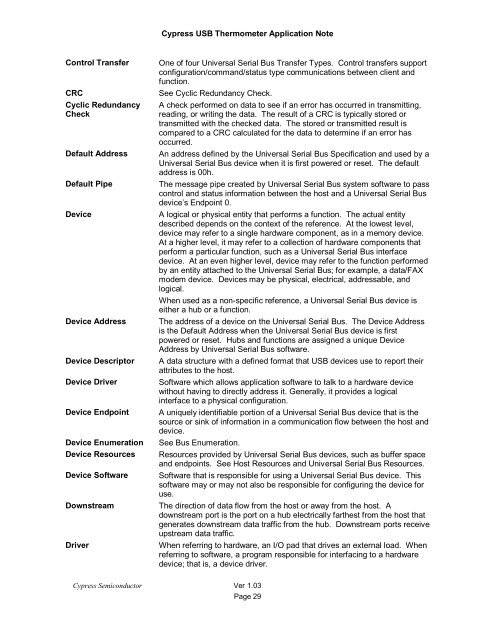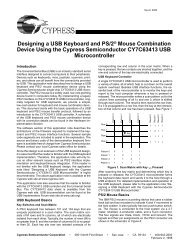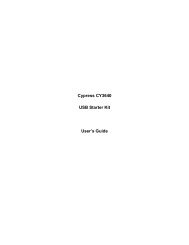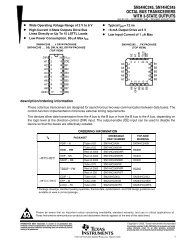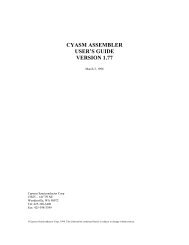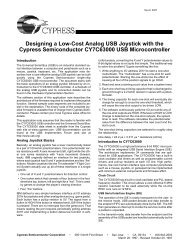Designing a Universal Serial Bus (USB) Device Using the Cypress ...
Designing a Universal Serial Bus (USB) Device Using the Cypress ...
Designing a Universal Serial Bus (USB) Device Using the Cypress ...
Create successful ePaper yourself
Turn your PDF publications into a flip-book with our unique Google optimized e-Paper software.
<strong>Cypress</strong> <strong>USB</strong> Thermometer Application Note<br />
Control Transfer<br />
CRC<br />
Cyclic Redundancy<br />
Check<br />
Default Address<br />
Default Pipe<br />
<strong>Device</strong><br />
<strong>Device</strong> Address<br />
<strong>Device</strong> Descriptor<br />
<strong>Device</strong> Driver<br />
<strong>Device</strong> Endpoint<br />
<strong>Device</strong> Enumeration<br />
<strong>Device</strong> Resources<br />
<strong>Device</strong> Software<br />
Downstream<br />
Driver<br />
One of four <strong>Universal</strong> <strong>Serial</strong> <strong>Bus</strong> Transfer Types. Control transfers support<br />
configuration/command/status type communications between client and<br />
function.<br />
See Cyclic Redundancy Check.<br />
A check performed on data to see if an error has occurred in transmitting,<br />
reading, or writing <strong>the</strong> data. The result of a CRC is typically stored or<br />
transmitted with <strong>the</strong> checked data. The stored or transmitted result is<br />
compared to a CRC calculated for <strong>the</strong> data to determine if an error has<br />
occurred.<br />
An address defined by <strong>the</strong> <strong>Universal</strong> <strong>Serial</strong> <strong>Bus</strong> Specification and used by a<br />
<strong>Universal</strong> <strong>Serial</strong> <strong>Bus</strong> device when it is first powered or reset. The default<br />
address is 00h.<br />
The message pipe created by <strong>Universal</strong> <strong>Serial</strong> <strong>Bus</strong> system software to pass<br />
control and status information between <strong>the</strong> host and a <strong>Universal</strong> <strong>Serial</strong> <strong>Bus</strong><br />
device’s Endpoint 0.<br />
A logical or physical entity that performs a function. The actual entity<br />
described depends on <strong>the</strong> context of <strong>the</strong> reference. At <strong>the</strong> lowest level,<br />
device may refer to a single hardware component, as in a memory device.<br />
At a higher level, it may refer to a collection of hardware components that<br />
perform a particular function, such as a <strong>Universal</strong> <strong>Serial</strong> <strong>Bus</strong> interface<br />
device. At an even higher level, device may refer to <strong>the</strong> function performed<br />
by an entity attached to <strong>the</strong> <strong>Universal</strong> <strong>Serial</strong> <strong>Bus</strong>; for example, a data/FAX<br />
modem device. <strong>Device</strong>s may be physical, electrical, addressable, and<br />
logical.<br />
When used as a non-specific reference, a <strong>Universal</strong> <strong>Serial</strong> <strong>Bus</strong> device is<br />
ei<strong>the</strong>r a hub or a function.<br />
The address of a device on <strong>the</strong> <strong>Universal</strong> <strong>Serial</strong> <strong>Bus</strong>. The <strong>Device</strong> Address<br />
is <strong>the</strong> Default Address when <strong>the</strong> <strong>Universal</strong> <strong>Serial</strong> <strong>Bus</strong> device is first<br />
powered or reset. Hubs and functions are assigned a unique <strong>Device</strong><br />
Address by <strong>Universal</strong> <strong>Serial</strong> <strong>Bus</strong> software.<br />
A data structure with a defined format that <strong>USB</strong> devices use to report <strong>the</strong>ir<br />
attributes to <strong>the</strong> host.<br />
Software which allows application software to talk to a hardware device<br />
without having to directly address it. Generally, it provides a logical<br />
interface to a physical configuration.<br />
A uniquely identifiable portion of a <strong>Universal</strong> <strong>Serial</strong> <strong>Bus</strong> device that is <strong>the</strong><br />
source or sink of information in a communication flow between <strong>the</strong> host and<br />
device.<br />
See <strong>Bus</strong> Enumeration.<br />
Resources provided by <strong>Universal</strong> <strong>Serial</strong> <strong>Bus</strong> devices, such as buffer space<br />
and endpoints. See Host Resources and <strong>Universal</strong> <strong>Serial</strong> <strong>Bus</strong> Resources.<br />
Software that is responsible for using a <strong>Universal</strong> <strong>Serial</strong> <strong>Bus</strong> device. This<br />
software may or may not also be responsible for configuring <strong>the</strong> device for<br />
use.<br />
The direction of data flow from <strong>the</strong> host or away from <strong>the</strong> host. A<br />
downstream port is <strong>the</strong> port on a hub electrically far<strong>the</strong>st from <strong>the</strong> host that<br />
generates downstream data traffic from <strong>the</strong> hub. Downstream ports receive<br />
upstream data traffic.<br />
When referring to hardware, an I/O pad that drives an external load. When<br />
referring to software, a program responsible for interfacing to a hardware<br />
device; that is, a device driver.<br />
<strong>Cypress</strong> Semiconductor Ver 1.03<br />
Page 29


